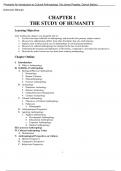(Humanity An Introduction to Cultural Anthropology 10e James Peoples, Garrick Bailey)
(Instructor Manual)
CHAPTER 1
THE STUDY OF HUMANITY
Learning Objectives
After reading this chapter, you should be able to:
1. List the four major subfields of anthropology and describe their primary subject matters.
2. Discuss how anthropology differs from other disciplines that also study humans.
3. Explain some of the practical uses of anthropology in solving human problems.
4. Discuss how cultural anthropology has changed in the last several decades.
5. Understand the meaning and importance of the holistic, comparative, and relativistic perspectives.
6. Describe the wider lessons one can learn from studying anthropology.
Chapter Outline
I. Introduction
A. What is Anthropology
II. Subfields of Anthropology
A. Biological/Physical Anthropology
1. Primatology
2. Human Variation
3. Paleoanthropology
4. Forensic Anthropology
B. Archaeology
1. Prehistoric Archeology
2. Historic Archeology
3. Cultural Resource Management
4. Contract Archaeology
C. Cultural Anthropology
1. Objectives of Cultural Anthropology
2. Fieldwork
a. Ethnography
D. Anthropological Linguistics
E. Applying Anthropology
1. Applied Anthropology
a. Development Anthropology
b. Educational Anthropology
c. Corporate Anthropology
d. Medical Anthropology
III. Careers in Anthropology
IV. Cultural Anthropology Today
A. Globalization
V. Anthropological Perspectives on Cultures
A. Holistic Perspective
B. Comparative Perspective
C. Relativistic Perspective
1
,Chapter 1: The Study of Humanity
1. Cultural Relativism
2. Ethnocentrism
VI. Some Lessons of Anthropology
Chapter Summary
Anthropology is the study of humanity. One of the field’s most remarkable features is its breadth of study.
The five subfields of anthropology cover just about every possible topic relating to humans. These
subfields are physical or biological anthropology, archaeology, cultural anthropology,
anthropological linguistics, and applied anthropology.
Those anthropologists specializing in physical anthropology can be paleontologists, primatologists, or
forensic anthropologists, to name a few. Archaeology is generally divided between prehistoric
archaeology and historic archaeology. Cultural anthropologists conduct fieldwork on a group of people
and make comparisons across cultures in order to better understand general principles as well as
variations in all dimensions of human life. Anthropological linguists study the relationship between
language and other aspects of human behavior. Applied anthropologists use their knowledge and
research skills to help solve practical problems in medicine, development, and education.
Undergraduates with a degree in anthropology have the skills to study human issues from a variety of
perspectives, to observe human behavior, and appreciate the diversity of the human experience.
Prior to the 1970s, most anthropologists studied small-scale cultures in far-off places. Today
anthropologists study the culture of groups within post-industrial societies, as well as global communities
and issues. Globalization has become a central topic of investigation for anthropologists who are
concerned with the impact at the local level. As anthropologists have expanded the range of their study,
the boundaries between anthropology and other disciplines have blurred. Still, anthropology is
distinguished by its emphasis on fieldwork and its global and comparative perspective. In addition,
anthropology is unique in the importance it attaches to studying cultures and communities holistically
and comparatively. Mild ethnocentrism is unavoidable; anthropologists find extreme ethnocentrism
objectionable. Relativism is an important methodological principle, but should not be confused with
moral relativism or an “anything goes” attitude.
The value of studying anthropology can be seen in some of its accomplishments. Anthropologists have
popularized the concept of culture and demonstrated that race and culture are independent of each other.
The classification of people into discrete races is a cultural construction rather than a biological
construction. As globalization continues, it is more important than ever before to understand and
appreciate cultural and physical diversity.
2
,Humanity: An Introduction to Cultural Anthropology, 10e Instructor’s Manual
Key Terms
anthropology ethnology
archaeology fieldwork
prehistoric archaeology ethnography
historic archaeology anthropological linguistics
biological (physical) anthropology applied anthropology
primatology medical anthropology
human variation globalization
paleoanthropology holistic perspective
forensic anthropology comparative perspective
cultural anthropology cultural relativism
social anthropology ethnocentrism
sociocultural anthropology culture
Suggested Supplementary Lectures
The Subfields of Anthropology. The breadth of our field can be introduced through an introduction of the
various subfields of anthropology. Each subfield could be summarized as to its theoretical base, its
various areas of research, its percentage of practitioners, and a brief example of recent research. Most
subfields publish this sort of information in their journals or newsletters. Another source of topics for
examples might be from recent news media that your students might have heard about, and that might
even have motivated your students to take your course.
The Garbage Project. Discuss the Garbage Project, a research project of the University of Arizona at
Tucson, as an example of contemporary archaeology. Archaeologists excavated landfills across the
country as if they were a more conventional dig site. The results of their research indicated that various
kinds of paper, as well as construction debris, comprised the majority of the garbage by volume.
Information about the Garbage Project and the impact it has had on environmental protection efforts is
available from a number of sites on the Internet.
What is Unique about Anthropology? Another way to discuss the breadth of anthropology and its holistic
perspective is to compare and contrast it with the various disciplines within the arts and humanities and
the natural sciences. For example, how do anthropologists bring the scientific method of the natural
sciences together with some of the humanistic approaches to the study of human societies? What should
be the role of anthropologists on the Human Genome Diversity Project? These and many other questions
are hotly debated among our colleagues and our students are interested in them as well. Comparing one’s
sociology department to the anthropologists on campus is another great way to draw differences. Students
may compare the modern, developed spaces that are generally the sociological focus, while the
anthropological field tends more toward broader, holistic lenses. Consider bringing in ethnographic case
studies to show students, for example, The Coming of Age in Samoa (M. Mead) and The Coming of Age
in Second Life (T. Boellstorff) and discuss how anthropological and sociological foci can overlap.
Anthropology and Race. It is difficult to study ourselves in the same scientific way in which we study
other species. Aristotle and Linnaeus, for example, described human races in cultural and ethnocentric
ways. Discuss why many anthropologists agree that races don’t exist or that they do not have biological
reality. Ever since the early 1900s when Boas and Kroeber separated social history from human biology,
anthropology has exposed the ethnocentrism and racism of eugenics or of I.Q. differences between races.
The American Anthropological Association has an on-going project, “The Race Project” which can
elaborate on the modern issue of race and social implications.
3
, Chapter 1: The Study of Humanity
What Don’t We Know? What issues, problems, and questions should anthropologists address? This
question was asked recently in an anthropology newsletter in an attempt to motivate students towards the
excitement of research on the unanswered questions that they are most interested in. Some typical
questions might be: (a) Where did we come from, and when did we get culture? (b) What will be some of
the problems and advantages of electronic communication? (c) Will materialism consume the planet? and
(d) When did we get language?
Why study anthropology? Introduce students to the wide range of applications of anthropology, and what
kinds of careers an anthropology degree might lead to. Show the film, “Anthropologists at Work: Careers
Making a Difference,” available from the American Anthropological Association.
Discussion Questions
1. Ask students to share their preconceived ideas about the work of anthropologists, and ask them to
consider where these ideas come from. There are anthropologists in popular culture (e.g. Kathy
Reichs in Bones, and Indiana Jones) that may or may not present a realistic view of the field of
anthropology. Ask students to discuss whether they believe these media images of anthropology
are beneficial or detrimental (or neutral) to the discipline; why?
2. Give each student a world map with only the outline of nations drawn in. Ask students to locate
nations of your choice. Have students exchange maps (without their names on them) several
times (to avoid any embarrassment). Project a blank map and ask students to share the locations
marked on the maps they hold (not their own). Ask the class to consider the extent of their
geographical knowledge. Discuss the factors that might lead to some having a greater knowledge
of world geography than others (e.g. having traveled, being an international student).
3. Ask students who have visited other countries to share their memories of the things that stood out
to them the most. They will likely describe cultural practices that are different from their own.
Use this opportunity to emphasize that cultural differences are the “easiest” to note and therefore
the easiest to emphasize. The student will likely take for granted the similarities, which, of
course, are also the subject matter of anthropology. If there are foreign students in the class, you
can also ask them their first impressions of this country.
4. The Census 2010 included questions about race, in spite of continued debate about its relevance.
The American Anthropological Association made a recommendation to eliminate the word “race”
from the 2010 Census. Ask students to discuss whether or not they think questions about race
should still be asked. Regardless of their personal views, ask them to consider reasons for and
against including questions about race.
5. Encourage students to be on the lookout for references to anthropology in magazines and
newspapers, in other college texts, and/or in the television programs they watch. Have them bring
these examples to class and use them as the basis for discussion.
6. Talk about the limitations of relativism (here in the sense of moral relativism). Present some cases
in which Western concepts of right and wrong are so seriously violated that a relativistic stance
must be challenged — e.g., cannibalism, head-hunting, infanticide, oppression of women,
warfare, slavery, and so forth. Present the argument that acceptance of practices is not necessary
in order to understand their context and causes. Engage students in a discussion of whether or not
they agree with this position.
4





